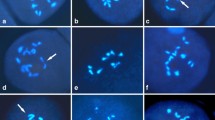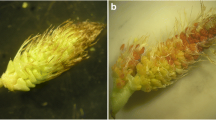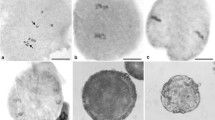Abstract
Diploid and triploid intergeneric hybrids obtained by crosses among Gloriosa superba ‘Lutea’ (2n = 2x = 22), G. ‘Marron Gold’ (2n = 4x = 44), Littonia modesta (2n = 2x = 22), and Sandersonia aurantiaca (2n = 2x = 24) were analyzed for their meiotic chromosome pairing in pollen mother cells by genomic in situ hybridization (GISH) with digoxigenin-labeled total DNA of one parent as probe. Chromosomes from each parent could be clearly distinguished in pollen mother cells of all the five intergeneric hybrids by GISH. For three diploid hybrids, L. modesta × G. superba ‘Lutea’ (2n = 2x = 22), L. modesta × S. aurantiaca (2n = 2x = 23) and S. aurantiaca × G. superba ‘Lutea’ (2n = 2x = 23), 0.04−0.27 autosyndetic bivalents (intragenomic pairing of non-homologous chromosomes) and 0.13−0.36 allosyndetic bivalents (intergenomic chromosome pairing) were observed per pollen mother cell, indicating that there are some homologous chromosomal regions within each genome and among the genomes of Gloriosa, Littonia and Sandersonia. Differences in the average number of allosyndetic bivalents per pollen mother cell among different genome combinations may reflect the evolutionary distances among the three genera, and Gloriosa and Littonia may be closely related to each other, while Sandersonia may have relatively distant relationships with Gloriosa and Littonia. For two triploid hybrids, L. modesta × G. ‘Marron Gold’ (2n = 3x = 33) and S. aurantiaca × G. ‘Marron Gold’ (2n = 3x = 34), no allosyndetic bivalents were observed. Based on the results obtained in the present study, possible utilization of the diploid and triploid intergeneric hybrids for further breeding of colchicaceous ornamentals is discussed.

Similar content being viewed by others
References
Amano J (2008) Studies on intergeneric hybridization among colchicaceous ornamentals. PhD Thesis, Niigata University, Japan (in Japanese with English summary)
Amano J, Kuwayama S, Mizuta Y, Oomiya T, Nakamura T, Nakano M (2007) Early identification of intra- and intergeneric hybrids among colchicaceous ornamentals, Gloriosa spp., Littonia modesta Hook. and Sandersonia aurantiaca Hook., by flow cytometry and random amplified polymorphic DNA analyses. J Japan Soc Hort Sci 76:73–78
Amano J, Kuwayama S, Mizuta Y, Godo T, Okuno H, Nakano M (2008) Morphological characterization of three intergeneric hybrids among Gloriosa superba ‘Lutea’, Littonia modesta and Sandersonia aurantiaca (Colchicaceae). Hort Sci 43:115–118
Amano J, Nakazawa D, Kuwayama S, Mizuta Y, Okuno H, Watanabe Y, Godo T, Han D-S, Nakano M (2009) Intergeneric hybridization among colchicaceous ornamentals, Gloriosa spp., Littonia modesta and Sandersonia aurantiaca via ovule culture. Plant Biotechnol 26:535–541
Barba-Gonzalez R, Miller CT, Ramanna MS, Van Tuyl JM (2006) Nitrous oxide (N2O) induces 2n gametes in sterile F1 hybrids between Oriental × Asiatic lily (Lilium) hybrids and leads to intergenomic recombination. Euphytica 148:303–309
Cao M, Sleper DA, Dong F, Jiang J (2000) Genomic in situ hybridization (GISH) reveals high chromosome pairing affinity between Lolium perenne and Festuca mairei. Genome 43:398–403
Dahlgren RMT, Clifford HT, Yeo PF (1985) The families of monocotyledons. Springer-Verlag, Berlin
Dunn BL, Lindstrom JT (2007) Oryzalin-induced chromosome doubling in Buddleja to facilitate interspecific hybridization. Hort Sci 42:1326–1328
Ge X-H, Li Z-Y (2007) Intra- and intergenomic homology of B-genome chromosomes in trigenomic combinations of the cultivated Brassica species revealed by GISH analysis. Chromosom Res 15:849–861
Hasegawa Y, Nukui S, Okazaki K (2013) Production of unreduced male and female gametes in hybrid lilies by high temperature treatment. Breed Sci 15(suppl. 2):114 (in Japanese)
Isshiki A, Taura T (2003) Fertility restoration of hybrids between Solanum melongena L. and S. aethiopicum L. Gilo Group by chromosome doubling and cytoplasmic effect on pollen fertility. Euphytica 134:195–201
Ji Y, Pertuze R, Chetelat RT (2004) Genome differenciation by GISH in interspecific and intergeneric hybrids of tomato and related nightshades. Chromosom Res 12:107–116
Kamstra SA, Kuipers AGJ, De Jeu MJ, Ramanna MS, Jacobsen E (1999) The extent and position of homoeologous recombination in a distant hybrid of Alstromeria: a molecular cytogenetic assessment of first generation backcross progenies. Chromosoma 108:52–63
Kuwayama S, Nakamura T, Mizuta Y, Oomiya T, Nakano M (2005) Cross-compatibility in interspecific and intergeneric hybridization among the Colchicaceous ornamentals. Gloriosa spp., Littonia modesta and Sandersonia aurantiaca. Acta Hort 673:421–427
Lim KB, Ramanna MS, Jacobsen E, Van Tuyl JM (2003) Evaluation of BC2 progenies derived from 3x−2x and 3x−4x crosses of Lilium hybrids: a GISH analysis. Theor Appl Genet 106:568–574
Lu M, Zhang P, Kang X (2013) Induction of 2n female gametes in Populus adenopoda Maxim by high temperature exposure during female gametophyte development. Breed Sci 63:96–103
Marasek A, Hasterok R, Wiejacha K, Orlikowska T (2004) Determination by GISH and FISH of hybrid status in Lilium. Hereditas 140:1–7
Molnár I, Molnár-Láng M (2010) GISH reveals different levels of meiotic pairing with wheat for individual Aegilops biuncialis chromosomes. Biol Plant 54:259–264
Nakamura T, Kuwayama S, Tanaka S, Oomiya T, Saito H, Nakano M (2005) Production of intergeneric hybrid plants between Sandersonia aurantiaca and Gloriosa rothchildiana via ovule culture (Colchicaceae). Euphytica 142:283–289
Nakazawa D, Kishimoto T, Sato T, Saito T, Amano J, Kuwayama S, Okuno H, Godo T, Watanabe Y, Han D-S, Nakano M (2011) Genomic in situ hybridization (GISH) analysis of intergeneric hybrids in Colchicaceae. Euphytica 181:197–202
Nordenstam B (1998) Colchicaceae. In: Kubitzki K (ed) The families and genera of vascular plants, vol 3. Springer-Verlag, Berlin, pp 175–185
Parokonny AS, Marshall JA, Bennett MD, Cocking EC, Davey MR, Power JB (1997) Homoeologous paring and recombination in backcross derivatives of tomato somatic hybrids [Lycopersicon esculentum (+) L. peruvianum]. Theor Appl Genet 94:713–723
Pendinen G, Spooner DM, Jiang J, Gavrilenko T (2012) Genomic in situ hybridization reveals both auto- and allopolyploid origins of different North and Central American hexaploid potato (Solanum sect. Petota) species. Genome 55:407–415
Ramanna MS, Jacobsen E (2003) Relevance of sexual polyploidization for crop improvement—a review. Euphytica 133:3–8
Rogers SO, Bendich AJ (1985) Extraction of DNA from milligram amounts of fresh, herbarium and mummified plant tissues. Plant Mol Biol 5:69–76
Schwarzacher T, Leitch AR, Bennett MD, Heslop-Harrison JS (1989) In situ localization of parental genomes in a wide hybrid. Ann Bot 64:315–324
Van Tuyl JM (1989) Research on mitotic and meiotic polyploidization in lily breeding. Herbertia 45:97–103
Van Tuyl JM, Lim KB (2003) Interspecific hybridization and polyploidizition as tools in ornamental plant breeding. Acta Hort 612:13–22
Van Tuyl JM, Meijer H, Van Diën MP (1992) The use of oryzalin as an alternative for colchicine in in vitro chromosome doubling of Lilium and Nerine. Acta Hort 325:625–630
Vinnersten A, Reeves G (2003) Phylogenetic relationships within Colchicaceae. Am J Bot 90:1455–1462
Vu HQ, Yoshimatsu Y, Khrustaleva LI, Yamauchi N, Shigyo M (2012) Alien genes introgression and development of alien monosomic addition lines from a threatened species, Allium roylei Stearn, to Allium cepa L. Theor Appl Genet 124:1241–1257
Yao X-C, Ge X-H, Chen J-P, Li Z-Y (2010) Intra- and intergenomic chromosome pairings revealed by dual-color GISH in trigenomic hybrids of Brassica juncea and B. carinata with B. maurorum. Genome 53:14–22
Zhou S, Ramanna MS, Visser RGF, Van Tuyl JM (2008) Genome composition of triploid lily cultivars derived from sexual polyploidization of Longiflorum × Asiatic hybrids (Lilium). Euphytica 160:207–215
Acknowledgments
This work was supported in part by a Grant-in-Aid for Scientific Research (No. 20580023) from the Ministry of Education, Culture, Sports, Science and Technology, Japan.
Author information
Authors and Affiliations
Corresponding author
Rights and permissions
About this article
Cite this article
Kishimoto, T., Yamakawa, M., Nakazawa, D. et al. Meiotic chromosome pairing in intergeneric hybrids of colchicaceous ornamentals revealed by genomic in situ hybridization (GISH). Euphytica 200, 251–257 (2014). https://doi.org/10.1007/s10681-014-1152-y
Received:
Accepted:
Published:
Issue Date:
DOI: https://doi.org/10.1007/s10681-014-1152-y




